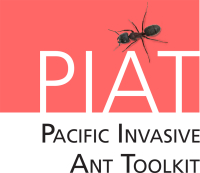Browsing ant
|
harms crops |
harms wildlife |
lives on ground |
day active |
|
Scientific name: Lepisiota frauenfeldi formerly Acantholepis frauenfeldi Size: 3-4 mm Colour: uniform shiny dark brown General description: the browsing ant has long legs and antennae and appears quite shiny. When disturbed this species runs around rapidly in a haphazard fashion, much like crazy ants do. Workers all look the same (monomorphic). Habitat and nesting: very little is known about the biology of the browsing ant. In Australia they are known to nest in very dry areas, where they make loose nests, often in sand patches or under logs, sheets of tin, sidewalk edges or in piles of rubble. Rate of spread: unknown. Distribution: see our invasive ant distributions page for the worldwide distribution of the browsing ant. Reproduction: information not available.
|
A browsing ant worker (© Alex Wild)
A browsing ant worker specimen (© Western Australian Agriculture Authority, 2013–2016) |
|
Browsing ant nests in a sandy patch (© Marc Widmer, Western Australian Agriculture Authority) |
Browsing ants run around frantically when disturbed (© Western Australian Agriculture Authority, 2013–2016) |
For a detailed description and identification of browsing ants:
Social, agricultural and economic impacts of the browsing ant
This ant species is an emerging invader and its full impacts are not yet known. It can form supercolonies, so has the potential to become a serious pest to humans if it were to establish in an urban area and reach high abundances. Browsing ants farm sap-sucking insects which can damage plants. When abundances of this ant are high it has been known to displace other ants and invertebrates. It also preys upon other ant species so could harm native ecosystems by decreasing native ant biodiversity and disrupting the ecosystem processes that those ants provide.
Management
If you are interested in getting rid of browsing ants, have a look at the management programme case study for this species to see examples of other control programmes that target them.
Information sources
AntWeb, Lepisiota
AntWiki, Browsing ant
Department of Agriculture and Food, Western Australia (DAFWA), Browsing ant
Content reviewed by Eli Sarnat, Antwork Consulting, LLC, June 2017




